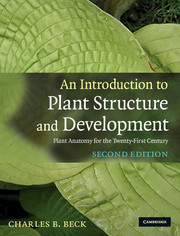Book contents
- Frontmatter
- Contents
- Preface to the second edition
- Preface
- Acknowledgements
- General references
- Chapter 1 Problems of adaptation to a terrestrial environment
- Chapter 2 An overview of plant structure and development
- Chapter 3 The protoplast of the eukaryotic cell
- Chapter 4 Structure and development of the cell wall
- Chapter 5 Meristems of the shoot and their role in plant growth and development
- Chapter 6 Morphology and development of the primary vascular system of the stem
- Chapter 7 Sympodial systems and patterns of nodal anatomy
- Chapter 8 The epidermis
- Chapter 9 The origin of secondary tissue systems and the effect of their formation on the primary body in seed plants
- Chapter 10 The vascular cambium: structure and function
- Chapter 11 Secondary xylem
- Chapter 12 The phloem
- Chapter 13 Periderm, rhytidome, and the nature of bark
- Chapter 14 Unusual features of structure and development in stems and roots
- Chapter 15 Secretion in plants
- Chapter 16 The root
- Chapter 17 The leaf
- Chapter 18 Reproduction and the origin of the sporophyte
- Glossary
- Index
- References
Chapter 16 - The root
Published online by Cambridge University Press: 05 June 2012
- Frontmatter
- Contents
- Preface to the second edition
- Preface
- Acknowledgements
- General references
- Chapter 1 Problems of adaptation to a terrestrial environment
- Chapter 2 An overview of plant structure and development
- Chapter 3 The protoplast of the eukaryotic cell
- Chapter 4 Structure and development of the cell wall
- Chapter 5 Meristems of the shoot and their role in plant growth and development
- Chapter 6 Morphology and development of the primary vascular system of the stem
- Chapter 7 Sympodial systems and patterns of nodal anatomy
- Chapter 8 The epidermis
- Chapter 9 The origin of secondary tissue systems and the effect of their formation on the primary body in seed plants
- Chapter 10 The vascular cambium: structure and function
- Chapter 11 Secondary xylem
- Chapter 12 The phloem
- Chapter 13 Periderm, rhytidome, and the nature of bark
- Chapter 14 Unusual features of structure and development in stems and roots
- Chapter 15 Secretion in plants
- Chapter 16 The root
- Chapter 17 The leaf
- Chapter 18 Reproduction and the origin of the sporophyte
- Glossary
- Index
- References
Summary
Perspective: evolution of the root
The anatomy of the root reflects its origin, its subterranean environment, and its function. The first vascular plants (Rhyniophyta) lacked roots, and absorption of water and nutrients was facilitated by rhizoids. Roots evolved in the seed plant clade (rhyniophytes, trimerophytes, progymnosperms, seed plants) as well as in lycophytes, sphenophytes, and ferns in response to the pressures of a land environment and increasing plant size. During their evolution important functions such as anchorage, absorption and transport of minerals and water, and storage of photosynthate were established. In some ways, however, roots changed relatively little through time, resulting from the subterranean environment in which they evolved, and the fact that roots were, thus, not exposed to the same intense selection pressures as stems.
The seed plant root (Fig. 16.1a, b) is considered by most researchers to be an evolutionarily modified stem although it has also been suggested that it might be an entirely new organ that evolved independently of the stem. The predominant view is supported by the fact that the structure of the root of extant plants is remarkably similar to the anatomy of the stem of their ancestors. Even in many plants with stems of siphonostelic or eustelic structure, the roots are protostelic (Fig. 16.1b), also a feature of the stems of very primitive plants. Roots with central piths have an alternate arrangement of xylem and phloem that may reflect a protostelic origin.
- Type
- Chapter
- Information
- An Introduction to Plant Structure and DevelopmentPlant Anatomy for the Twenty-First Century, pp. 279 - 323Publisher: Cambridge University PressPrint publication year: 2010

